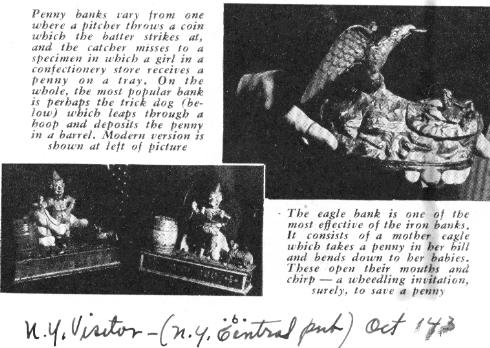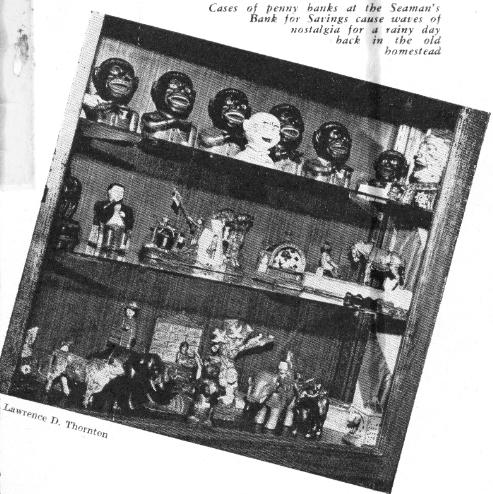|
New York Visitor - Central Park, October 1943
WHEN THRIFT
WAS FUN
Amusing Penny Banks Explain Why
Some Coppers Were Saved

Doubt as to why past decades were more thrifty than the present one is
dispelled by a visit to the Seamen's Bank for Savings, 74 Wall St. Here under
three Ernest Peixotto murals, including one of Washington landing in a decorated
barge at Wall and Pearl Sts. (now commemorated by a bronze tablet only a short
walk east from the bank), is a fascinating collection of 500 penny banks. Their
assembling was accidental. Fifteen years ago, Elmer Rand Jacobs, executive
vice-president of the Seamen's Bank, strolled into an antique shop while on a
vacation junket and found himself overcome with nostalgic memories on perceiving
for sale a battered Tammany bank. This consisted of an effigy of Boss Tweed,
which took a proffered penny and slipped it in a vest pocket. Since Mr. Jacobs
had played with this toy in his boyhood and had because of it or in spite of it
grown up into a banker, he purchased the object. Its possession subsequently
diverted his attention to all toy banks which he bought whenever he discovered
an original that was either unique or rare. Eventually, therefore he acquired
many specimens which were taken to the Seamen's Bank and, in 1937, placed under
the guardianship of another officer. Thornton C. Thayer, treasurer. This
hobby-lover not only cherished the original display, but increased it by adding
rarities which he himself unearthed.
The collection as it now
stands is notable not only because of the many materials comprising the banks
and the age and workmanship represented by them, but also because of the
remarkable imaginative ingenuity displayed. Outstanding among the materials is a
hen of 15th century French earthenware, turned by wheel and finished by hand.
The piece is not particularly attractive except for its age, but there are
dozens of birds, pigs, elephants, horses, dogs, and the like of glass, pottery,
metal and kindred compositions which, when combined with a good design, are
attractive enough for a knicknack cabinet and in some cases even for mantel
decorations.
Although certain examples
are pictorially effective, the really outstanding section of the exhibition
consists of iron banks. These are equipped with springs and levers which
accomplish surprising effects for the astonishment, bewilderment and delight of
the child, not to mention the amusement of his parents, who enjoy kicking a
penny around so to speak, until it is snugly ensconced in the receptacle
intended for its temporary entombment.
The mechanics of some of
the banks is surprisingly simple; that of others more complex, but the joy of
being presented with any of them can easily be imagined. Occasionally an
exceedingly human touch obtrudes itself. One bank, for example, bears the
scratched words, "Kittie, Xmas, 1871," thus conjuring up a little girl sitting
with a small iron house in her lap feeding pennies into it in order to see a
monkey emerge from the roof and waggle its head. For other Yuletide-minded
misses, there is a Santa Claus who drops the penny right down the chimney.
The banks, however, are
by no means intended only for the "sugar and spice" sex. Many are designed for
both girls and boys, and who would not be thrilled to drop a penny in the slot
and see two horses race around a track? A few banks are obviously for boys, such
as one where the traditional William Tell apple is shot from a child's head, or
another where a soldier fires into a tree trunk, or still another where Teddy
Roosevelt shoots at a tree from which a bear emerges at the top. Some banks seem
to have been manufactured for special occasions. One of these, for instance,
could not but make an appeal to a young invalid, for a penny is placed on a
large spoon which is thrust like medicine into a child's mouth by a colored
mammy. Again, almost any six-year-old would save money for a circus if his coin
when placed in a dog's mouth were carried by the canine through a hoop held by a
clown and safely deposited in a bank beyond.
A definite attempt at
humor is made in many of the banks. Among them is Chief Big Moon sitting before
his tepee holding a fish. The deposited coin releases a spring which causes a
hidden frog to leap out of a pond and gobble the fish. Who wouldn't laugh at
this? It is also easy to imagine roars of childish laughter over Paddy and his
pig. In this contraption a coin is placed on the pig's snout held between
Paddy's legs and a lever is released which causes the pig to kick up and send
the coin into Paddy's mouth.
Occasionally even the
iron banks are pictorially effective. Among them is a conception of an eagle and
her eaglets. In this, the mother bird feeds a penny into the nest where her two
babies await food. As the mother's head approaches, the mouths of the little
ones open and they chirp. This particular specimen sold in 1887 for about $8.50
per dozen and retailed for $1.50. Now the same bank would cost $5.00 or more
because of the increased expense of manufacture and the difficulties presented
in casting.
Subjects are endless — a
buffalo which bucks a Negro up a tree; a dentist bank in which both the dentist
and his patient fall over when a tooth is extracted; a Liberty bell which rings
when the coin is deposited; a girl who skips rope when the right mechanism is
released; and many, many more specimens. Some of them recall childhood days;
some are interesting as typifying the toys of other children. All are amusing,
and the Seaman's Bank for Savings is hospitable about allowing visitors to view
its treasures. Either the IRT-Lexington or Broadway - Seventh Avenue Express
Subway to Wall St. is the quickest way of reaching the collection and seeing
this quaint section of New York, where many Bronze plaques commemorate events of
the past.

Buy War Bonds and Stamps
|


